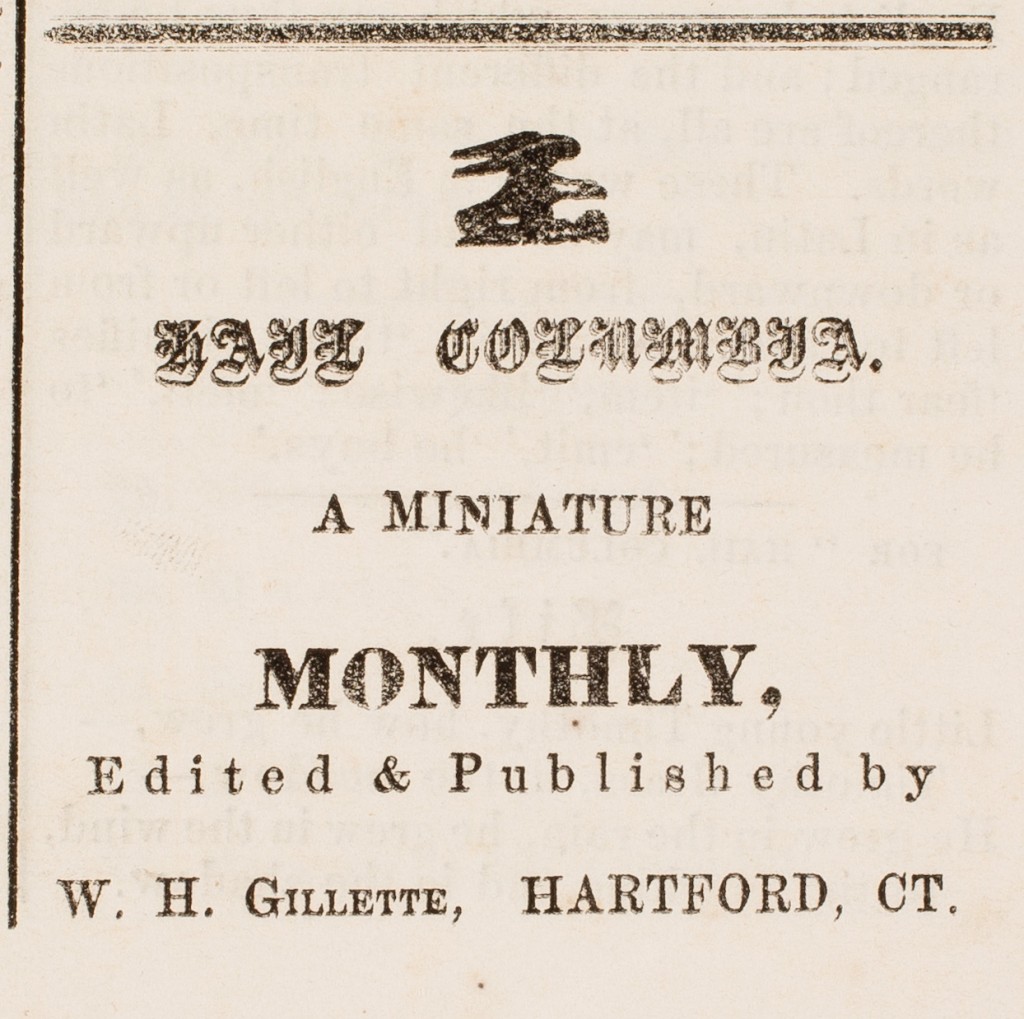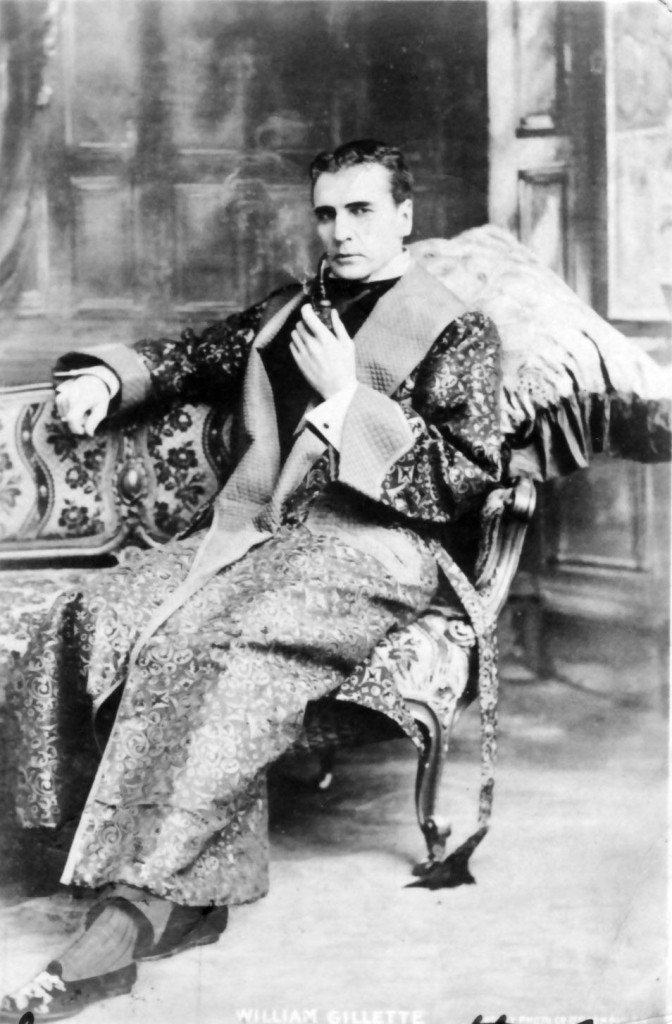 A recently acquired amateur newspaper, Hail Columbia, published in Hartford by W.H. Gillette, sent this serials cataloguer on a hunt for the full name of the editor. The paper itself gave no clues, and it was fairly typical of such things—riddles, poetry, bits and pieces of “news,” notices of other amateur newspapers and the like. It must have been notable for something, as it was mentioned in the Hartford Courant, evinced by a thank you nod from the editor in the July 1867 issue.
A recently acquired amateur newspaper, Hail Columbia, published in Hartford by W.H. Gillette, sent this serials cataloguer on a hunt for the full name of the editor. The paper itself gave no clues, and it was fairly typical of such things—riddles, poetry, bits and pieces of “news,” notices of other amateur newspapers and the like. It must have been notable for something, as it was mentioned in the Hartford Courant, evinced by a thank you nod from the editor in the July 1867 issue.
Hail Columbia was started in 1866 but there is no indication of how long it ran. Working through Ancestry.com, I discovered the editor was William H. Gillette, son of Senator Francis Gillette. William was born July 24, 1853, and the family lived at Nook Farm in Hartford, near such notables as Henry Ward Beecher, Harriet Beecher Stowe, Mark Twain, and Charles Dudley Warner (editor of the Courant, which may explain the notice!). Gillette was about fourteen when he edited and published Hail Columbia.
From there he went on to become an actor, Mark Twain getting him his first role in Twain’s own play The Gilded Age in 1875. Gillette became a success both as a playwright and an actor, with his most famous role being Sherlock Holmes. He had a friendship and correspondence with Sir Arthur Conan Doyle, in 1898 arriving at Doyle’s residence in a long gray cape and deerstalker hat. With his height and longish, aristocratic face and beaky nose, he was the perfect Sherlock Holmes. Doyle had written a play about his famous detective, which Gillette extensively rewrote and asked Doyle if he could “marry Holmes.” Doyle replied the he could marry him or murder him or do anything he liked with him. The result was a four-act play, combining elements from several of Doyle’s stories, including A Scandal in Bohemia and The Final Problem. Touches of A Study in Scarlet, The Sign of Four, The Boscombe Valley Mystery, and The Greek Interpreter were also incorporated.

Gillette’s portrayal of Holmes on the stage led to one of the more iconic representations of the detective, which never existed in the original stories. Although the cape and deerstalker hat appeared in the Strand Magazine serialization of the stories, the illustrations by Sidney Paget show Holmes with a straight stem pipe, not the curved calabash now associated with him. This was introduced by Gillette on stage, supposedly so that he could speak his lines more clearly with the curved stem. More likely it was because that type of pipe lent itself to a better view of the actor’s face! In any case, Gillette’s use of the calabash firmly entrenched that pipe in the Holmes canon, along with the violin, syringe, and magnifying glass.
Gillette was also an inventor and practical joker. His house in Haddam, now known as Gillette’s Castle, is an imposing fourteen-room mansion built of local, undressed fieldstone and has trap doors, secret passages, and intricate locks designed by the owner. It is surrounded by a miniature railway also designed and built by the actor. Gillette’s sitting room on the fourth floor was designed to replicate that of Sherlock Holmes, complete with the tobacco-stuffed Persian slipper hanging from the mantle. There is also a spring loaded bar that appeared and disappeared before guests. An inveterate animal lover, Gillette built a fountain in the conservatory for his two pet frogs, and had anywhere from fifteen to twenty cats in the house at one time. An advertisement placed in the Deep River Era by Gillette offered “Two perfectly black Tommy kittens to be given away, one all black, other black with white feet and underside. Both have double forepaws that is, seven toed. Not Persian, Angora or Siamese, But Real Cats they come of a family of great mousers. Anyone wanting one or both of these delightful felines must write stating qualifications. That is, we want to be sure that they do not go to stupid boobs who don’t know what a cat is. Would like to have a recommendation from last cats you have lived with, but probably that is asking too much. Address WG, Box 96, Hadlyme, Conn.”
Gillette died childless on April 29, 1937. His will stated
I would consider it more than unfortunate for me – should I find myself doomed, after death, to a continued consciousness of the behavior of mankind on this planet – to discover that the stone walls and towers and fireplaces of my home – founded at every point on the solid rock of Connecticut; – that my railway line with its bridges, trestles, tunnels through solid rock, and stone culverts and underpasses, all built in every particular for permanence (so far as there is such a thing); – that my locomotives and cars, constructed on the safest and most efficient mechanical principles; – that these, and many other things of a like nature, should reveal themselves to me as in the possession of some blithering saphead who had no conception of where he is or with what surrounded.

